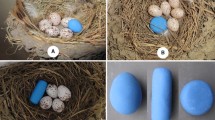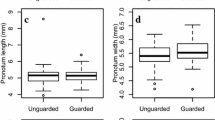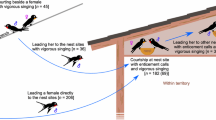Summary
The importance of mate guarding by males in the monogamous swallowHirundo rustica was studied by temporarily detaining the males. Mate guarding reduced the frequency of extra-pair copulations and of sexual chases involving female mates. Males participated in sexual chases more frequently if they had a non-fertile female. Neighbouring males of ‘widowed’ females increased their own mate guarding presumably in response to the experimentally increased rate of sexual chases. Neighbouring males with a fertile female increased their mate guarding more than did males with a non-fertile female.
Addition of eggs to swallow nests in the post-fledging period of the first brood induced mate guarding by male nest owners. These males also copulated more frequently with their mates than did control males. Neighbouring male swallows responded to the increased mate guarding by showing sexual interest in the guarded females.
removal of eggs from swallow nests during the laying period, leaving only one egg in the nest, resulted in reduced nest attendance by females. Male mates responded by increasing their mate guarding intensity as compared to controls, and neighbouring males showed an increased sexual interest in these females.
Similar content being viewed by others
References
Ascroft R (1976) A function of the pair bond in the common eider. Wildfowl 27:101–105
Barash DP (1981) Mate guarding and gallivanting by male holary marmots (Marmota caligata). Behav. Ecol Sociobiol 9:187–193
Beecher MD, Beecher IM (1979) Sociobiology of bank swallows: reproductive strategy of the male. Science 205:1282–1285
Birkhead TR (1979) Mate guarding in the magpiePica pica. Anim Behav 26:321–331
Birkhead TR, Atkin L, Møller AP (1987) Copulation behaviour of birds. Behaviour 101:101–138
Bishop YMM Fienberg SE, Holland PW (1975) Discrete multivariate analysis: theory and application MIT Press, Cambridge Mass
Björklund M, Westman B (1983) Extra-pair copulations in the pied flycatcher (Ficedula hypoleuca). Behav Ecol Sociobiol 13:271–275
Graham CE (1981) Reproductive biology of the great apes. Academic Press, New York
Lott DF (1981) Sexual behavior and intersexual strategies in American bison. Z Tierpsychol 56:97–114
Lumpkin S (1981) Avoidance of cuckoldry in birds: the role of the female. Anim Behav 29:303–304
Lumpkin S (1983) Female manipulation of male avoidance of cuckoldry behaviour in the ring dove. In: Wasser SK (ed) Social behavior of female vertebrates. Academic Press, New York, pp 91–112
MartinK (1984) Reproductive defence priorities of male willow ptarmigan (Lagopus lagopus): enhancing mate survival or extending paternity options? Behav Ecol Sociobiol 16:57–63
Møller AP (1985) Mixed reproductive strategy and mate guarding in a semi-colonial passerine, the swallowHirundo rustica. Behav Ecol Sociobiol 17:401–408
Møller AP (1987) Duration and intensity of mate guarding in the swallowHirundo rustica. Ornis Scand 18:95–100
Morris RD, Bidochka MJ (1982) Mate-guarding in herring gulls. Colon Waterbirds 5:124–129
Parker GA (1970) Sperm competition and its evolutionary consequences in the insect. Biol Rev 45:525–567
Ridley M (1983) The explanation of organic diversity. Clarendon Press, Oxford
Siegel S (1956) Nonparametric statistics for the behavioral sciences. McGraw-Hill Kogakusha, Tokyo
Sokal RR, Rohlf FJ (1981) Biometry. Freeman, San Francisco
Author information
Authors and Affiliations
Rights and permissions
About this article
Cite this article
Møller, A.P. Mate guarding in the swallowHirundo rustica . Behav Ecol Sociobiol 21, 119–123 (1987). https://doi.org/10.1007/BF02395439
Received:
Accepted:
Issue Date:
DOI: https://doi.org/10.1007/BF02395439




